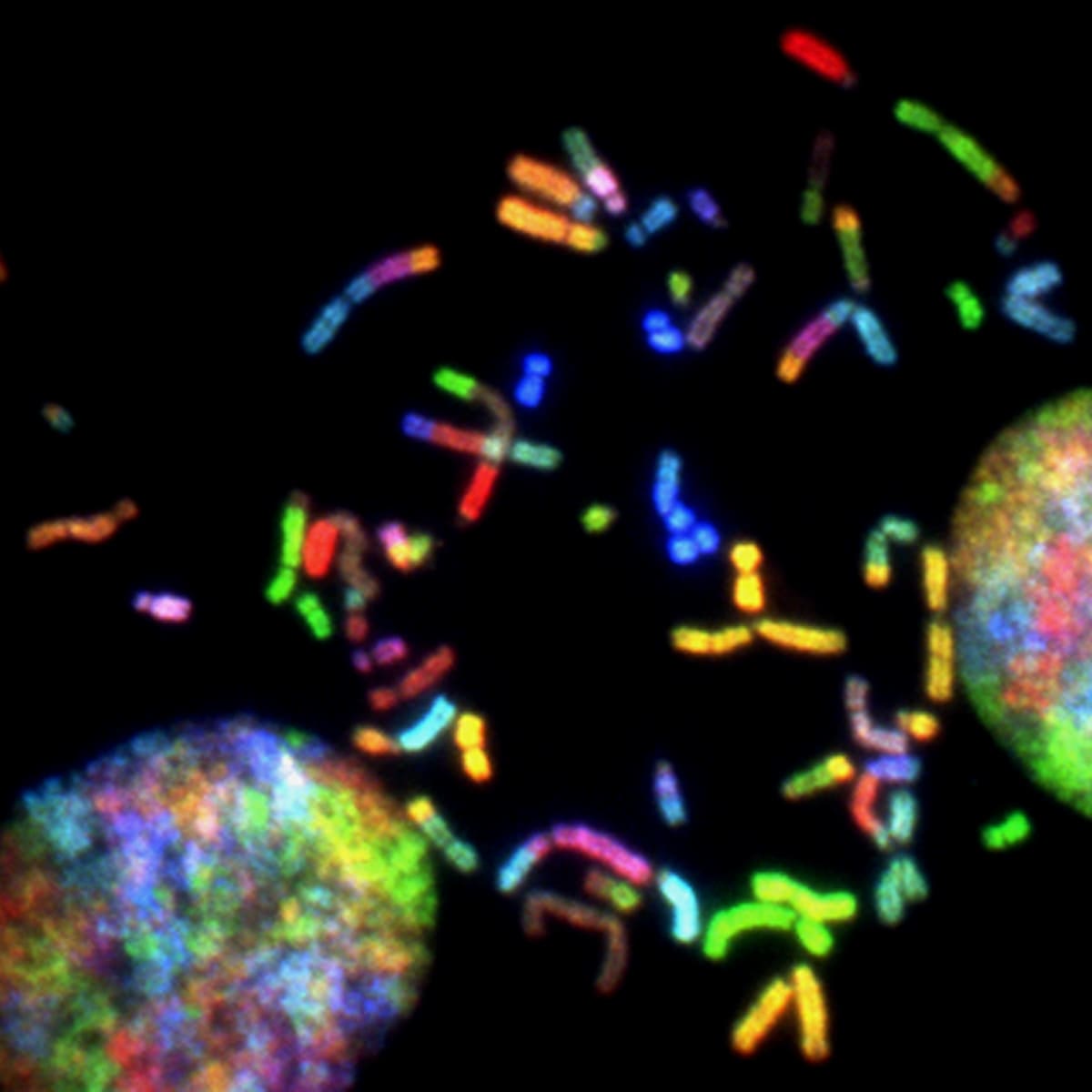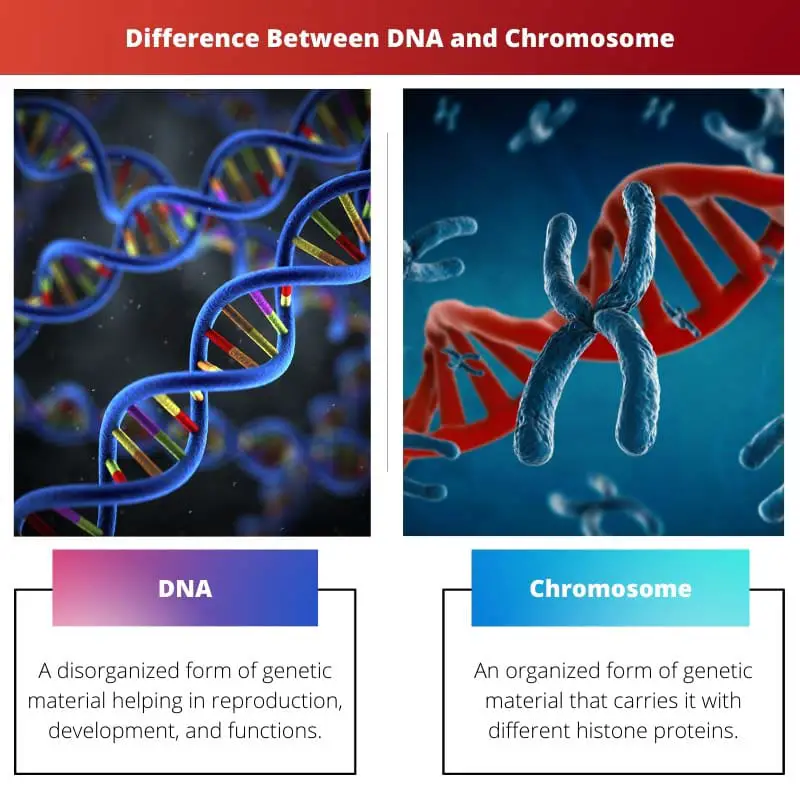Biology is the field of science that deals with the existence of life. Scientists have continuously researched the process of birth, reason, how it works, and what makes up an individual.
Researchers have also searched and studied the different functioning of body parts and organs. The inheritance of traits, genetic mapping, tracing chromosomes, and the assortment of the gene in the chromosome all of such things are related to the human directly and indirectly.
Key Takeaways
- DNA is a molecule that contains genetic information, while chromosomes are structures that organize DNA.
- Chromosomes consist of DNA wrapped around proteins called histones.
- Humans have 46 chromosomes, which carry thousands of genes made up of DNA.
DNA vs Chromosome
The difference between DNA and Chromosome is that DNA is the unorganized form of genetic material in the eukaryote and some prokaryotes whereas comparatively, on the other hand, Chromosome is the most organized form of carrying genetic material in different prokaryotes and eukaryotes. The structure of the DNA looks like a double helix that runs together and is attached to different bases, while the structure of a chromosome is formed by the coiling of a large thread on a histone protein.

DNA is the acronym for Deoxyribonucleotide acid. It was first discovered by a scientist named Johann Friedrich Miescher, who was also Swiss.
Scientists discovered it in the year the late 1860s. The composition of a DNA molecule is that it has a deoxyribose sugar chain on which nucleotides are attached with four different nitrogen bases that are – A. T. G, C.
DNA is a long chain that must be shortened by coiling to fit into a small, microscopic living cell. Thus it is coiled up and is commonly known as Chromosome.
The chromosome is the form that helps in passing on the genetic material from the parent to the next generation. The pair of two chromosomes are called sister chromatids.
Comparison Table
| Parameters of Comparison | DNA | Chromosome |
|---|---|---|
| Definition | A disorganized form of genetic material helping in reproduction, development, and functions | An organized form of genetic material that carries it with different histone proteins |
| Composition | Nucleotide bases, phosphate, and deoxyribose sugar | Histone proteins with DNA |
| Structure | Double-helix | Condensed |
| Function | Keep all the genetic information | Organize and pass on genetic information through the process of transcription. |
| Identification | Mainly through the process of gel electrophoresis | Through the process of karyotyping by freezing the chromosome at the metaphase plate |
| Discovered By | Johann Friedrich Miescher | Walther Flemming |
| Discovered In | The late 1860s | 1882 |
What is DNA?
DNA is a molecule consisting of all the genetic information carried from the parent to the next generation with the help of replication, transcription, and translation. The molecule of DNA forms a very long chain and is very unorganized.
It measures approximately up to 3 m.
DNA was discovered by a Swiss-based scientist named Johann Friedrich Miescher around the time of the late 1860s. The composition of DNA is based on three different components that are – backbone chain made up of sugar, phosphate groups, and four different nitrogenous bases – Adenosine (A), Thymine (T), Guanine (G), and Cytosine (C).
These four different nitrogenous bases are attached by very strong hydrogen bonds, and because of these bonds, the two strands of DNA can run parallel with each other.
DNA is said to be the genetic material for all eukaryotes and some prokaryotes. The location of the DNA is in the nucleus, while some organelles also have their DNA, for example – Chloroplast and Mitochondria.
DNA can be identified in the laboratory using the two different processes of gel electrophoresis.

What is Chromosome?
A chromosome is a molecule that carries genetic information from the parent body to the next generation. It can also be said to be the carrier of genetic material and is considered its most organized form.
The discovery of chromosomes took place in the year 1882 and was discovered by a scientist named Walther Flemming.
As a single DNA structure is about 3 m in length, it cannot be accumulated in a microscopic cell. Thus it is coiled very tightly around eight different histone proteins, which then form Nucleosome and which is also condensed to form Chromatin, and the structure is further condensed into a Chromosome.
Different organism contains a different number of chromosomes. Human beings have 46 chromosomes or 23 pairs or 22 homologous pairs, and 1 pair of sex chromosomes.
They can be identified by the process of karyotyping the metaphase plate.

Main Differences Between DNA and Chromosome
- DNA is a disorganized form of genetic material helping in reproduction, development, and functions, whereas comparatively, on the other hand, a chromosome is an organized form of genetic material carrying it from the parent to the next generation.
- A DNA molecule is comprised of four nitrogen bases – A, T, G, and C, deoxyribose sugar and phosphate group, whereas comparatively, on the other hand, a chromosome is comprised of histone proteins and DNA.
- The DNA molecule appears as a double-helix structure, whereas comparatively, on the other hand, the structure of a chromosome is condensed and complex.
- The main function of a DNA molecule is to keep genetic material, whereas comparatively, on the other hand, the main function of a chromosome is to pass the information from the parent to the next generation.
- DNA molecules can be identified by the process of gel electrophoresis, whereas comparatively, on the other hand, a chromosome can be identified by mapping them at the metaphase phase, and it is called karyotyping.
- Johann Friedrich Miescher discovered the DNA molecule, whereas comparatively, on the other hand, the chromosome was discovered by the scientist Walther Flemming.
- DNA molecule was discovered in the late 1860s, whereas comparatively, on the other hand, chromosome was discovered in the year 1882.

References
- https://www.sciencedirect.com/science/article/pii/B9780123226501501442
- https://link.springer.com/article/10.1007/s10956-006-9006-6
- https://royalsocietypublishing.org/doi/abs/10.1098/rstb.1986.0004
- https://meridian.allenpress.com/radiation-research/article-abstract/115/3/550/38586/The-Relationship-of-DNA-and-Chromosome-Damage-to

This article did a great job comparing the structure and function of DNA and Chromosomes. Their significance in genetics is well presented.
Agreed, the clear differences are well outlined in this article.
I appreciate the informative nature of this article, it’s important to learn about biology to understand how we work.
The detailed comparison of DNA and chromosomes is very comprehensive, I appreciate the scientific information provided here.
Interesting article, I appreciate the detailed description of the human chromosomes and the process of genetic heredity.
The importance of DNA and chromosomes in our existence is undeniable. The descriptions and differences between the two are very enlightening.
The human body is such an intricate mechanism. It’s fascinating to learn about how these tiny building blocks of life work together to build and maintain our body’s functions.
This article provides a very thorough explanation of the differences between DNA and chromosomes, very well researched.
This article provides a very insightful comparison between DNA and chromosomes, giving a clear understanding of their roles and composition.
The composition of the DNA and Chromosomes are meticulously described here, providing a very informative read.